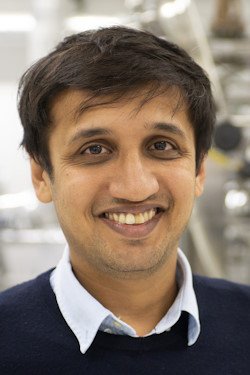Tanmay Bharat
2024 United Kingdom Award Finalist — Faculty

Current Position:
Programme Leader
Institution:
MRC Laboratory of Molecular Biology
Discipline:
Molecular & Cellular Biology

Current Position:
Programme Leader
Institution:
MRC Laboratory of Molecular Biology
Discipline:
Molecular & Cellular Biology
Recognized for: Developing cutting-edge techniques in electron cryotomography (cryo-ET) to create atomic-level pictures of cell-surface molecules produced by microscopic bacteria and archaea, as they form multicellular communities including biofilms and microbiomes. Bharat’s work has important biomedical implications, as most pathogenic bacteria infect humans through biofilm formation, but it also has implications for the fundamental understanding of the dynamics of cell-to-cell interactions that led to the evolution of multicellular life on Earth.
Areas of Research Interest and Expertise: Structural Biology, Microbiology, Multicellular Prokaryotes, Electron Tomography, Biofilms
Previous Positions:
Research Summary:
Although bacteria and archaea are classically considered single-cell organisms, they commonly assemble in complex multicellular communities. Some of these communities, such as bacterial biofilms, are biomedically important, as they are often associated with antibiotic-resistant human infections. However, relatively little is understood about how these multicellular communities are formed and maintained.
Microbiologist Tanmay Bharat, PhD, has developed and applied cutting-edge electron cryotomography (cryo-ET) techniques to solve atomic-level structures of nanometer-scale surface molecules directly from bacterial and archaeal cells. This work has revealed novel structural details and has shown how surface molecules are crucial in mediating cell-to-cell interactions that promote the formation of antibiotic-resistant biofilms and the formation of diverse microbial communities.
Bharat has resolved atomic structures of numerous proteins on the surface of bacteria and archaea, uncovering a surprising similarity of these proteins to antibodies from the immune system. These antibody-like proteins are known to be crucial for bacteria and archaea to differentiate between the same (“self”) species and other (“non-self”) species. Interestingly, Bharat has shown that such proteins are widespread across microbes, suggesting that these represent primordial recognition systems that may have been precursors to modern immune systems, which require distinguishing “self” from “non-self” entities to clear infections.
Bharat’s techniques in cryo-ET are at the leading edge of the technology, allowing researchers to perform structural analyses of individual molecules and structures in their native environment inside cells and tissues. This work has informed our fundamental understanding of microbial interactions and has been extended to reveal potential therapeutic avenues for inhibiting biofilm formation and for the production of synthetic biomaterials.
"I am delighted to be selected as a finalist for the UK Blavatnik award. I have long admired all previous honourees. This recognition is a testament to the hard work of colleagues in my lab – a big thanks to them."
Key Publications:
Other Honors:
| 2013 | Bayer Pharmaceuticals Promotionspreis (Best PhD Thesis), German Society for Biochemistry and Molecular Biology |
| 2017 | Sir Henry Dale Fellowship, Royal Society and Wellcome Trust |
| 2018 | International Prize Scholar, Vallee Foundation |
| 2019 | John Kendrew Award, EMBL Heidelberg |
| 2020 | Young Investigator Award, EMBO |
| 2020 | Philip Leverhulme Prize in the Biological Sciences, Leverhulme Trust |
| 2021 | Young European Investigator Award, Eppendorf |
| 2021 | Lister Prize, Lister Institute of Preventive Medicine |
| 2022 | Colworth Medal, The Biochemical Society |
| 2023 | Fleming Prize, The Microbiology Society |
In the Media:
Astrobiology – Elucidation of the Structure of the Surface Layer of Deinococcus Radiodurans, The Toughest Bacterium Known
Cystic Fibrosis Trust – Research Blast on Pseudomonas
Action Medical Research Charity – Cystic Fibrosis: Improving Treatment For Lung Infections